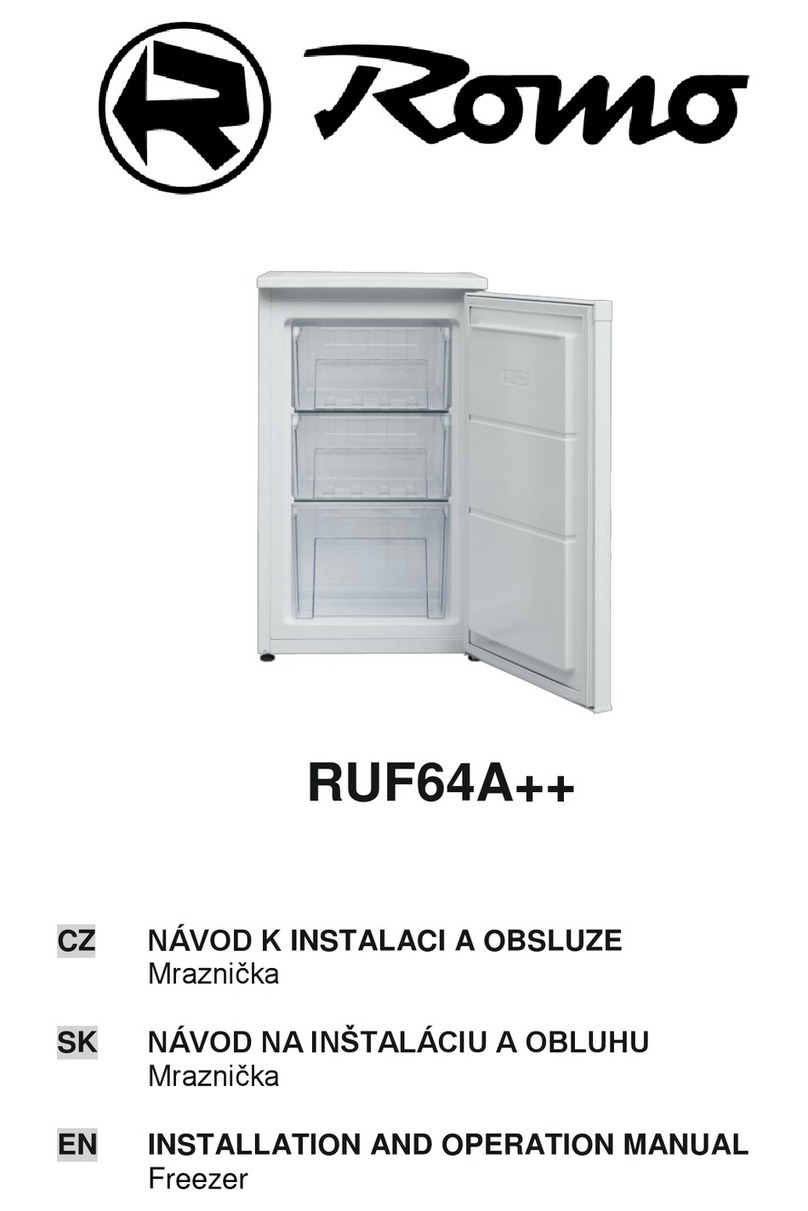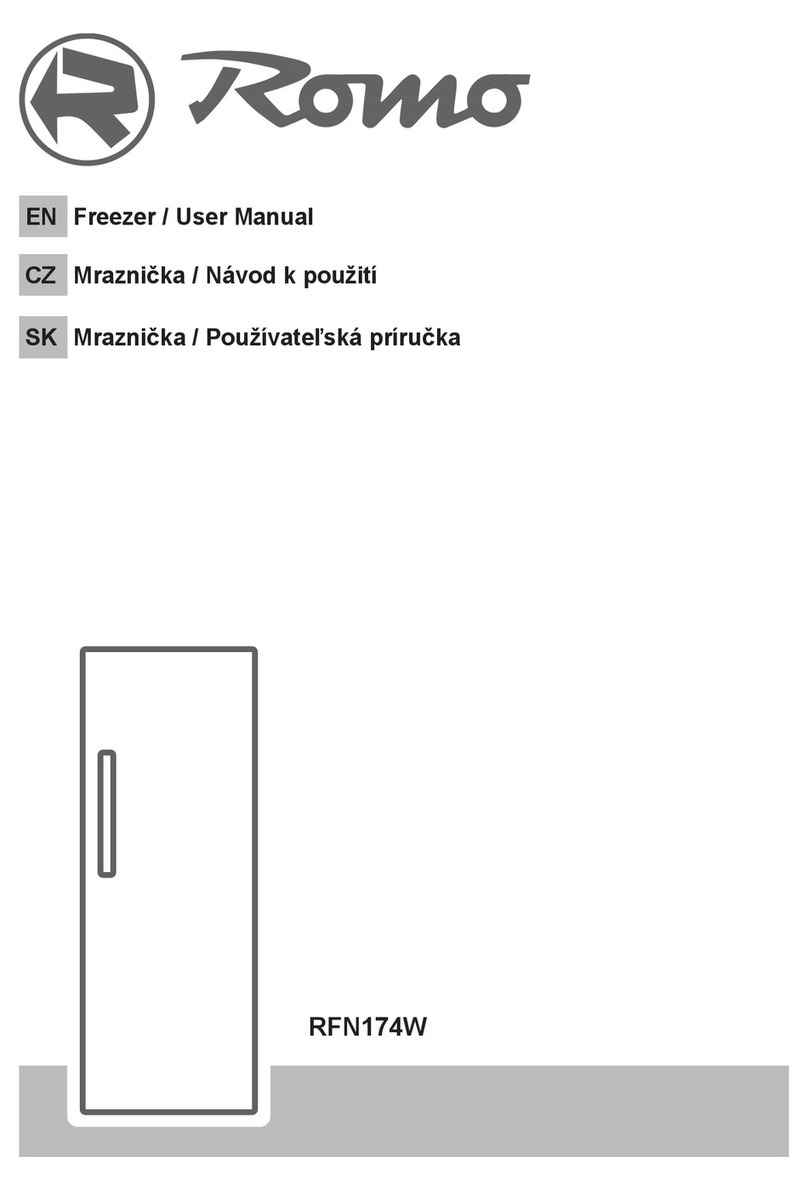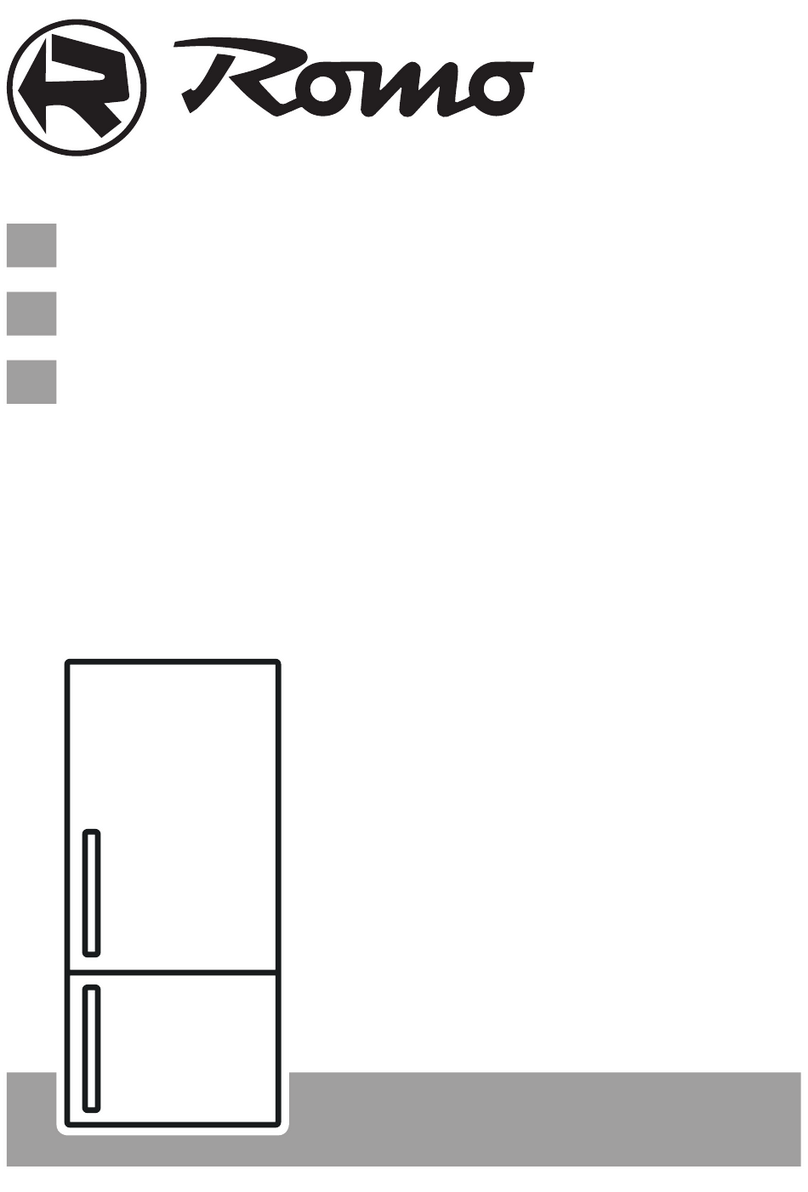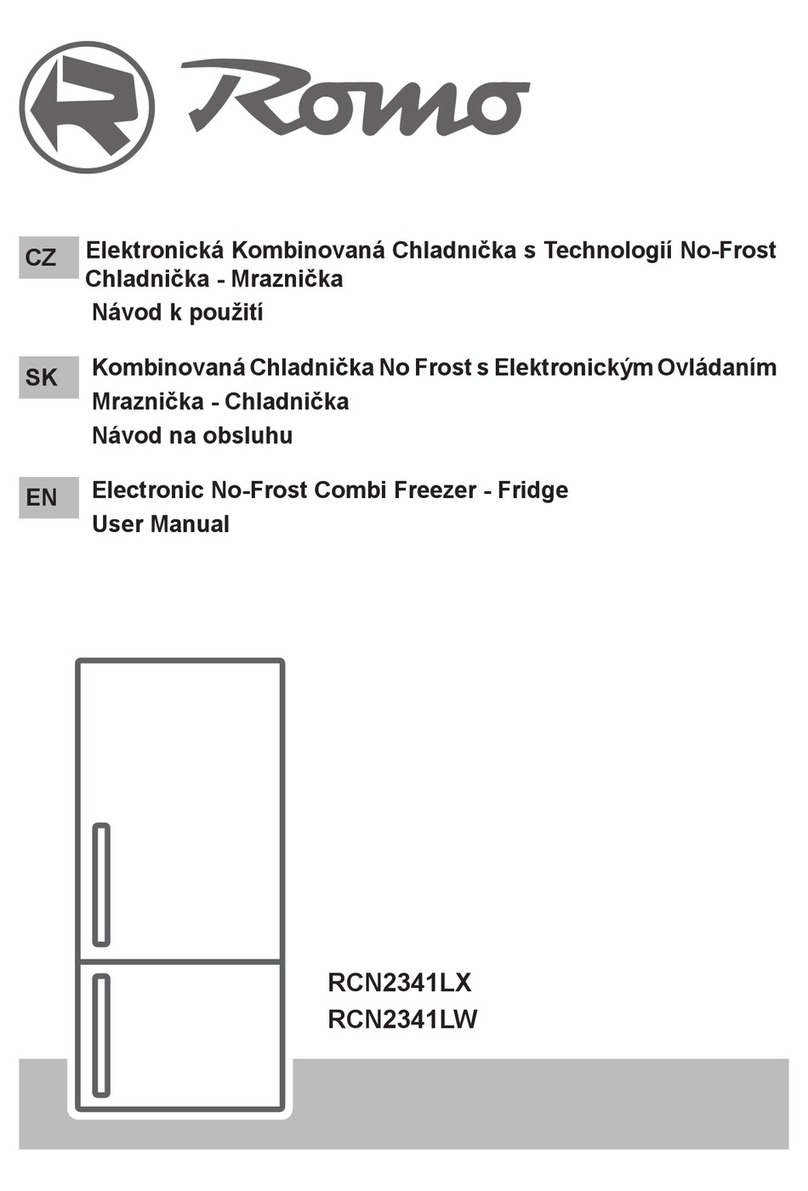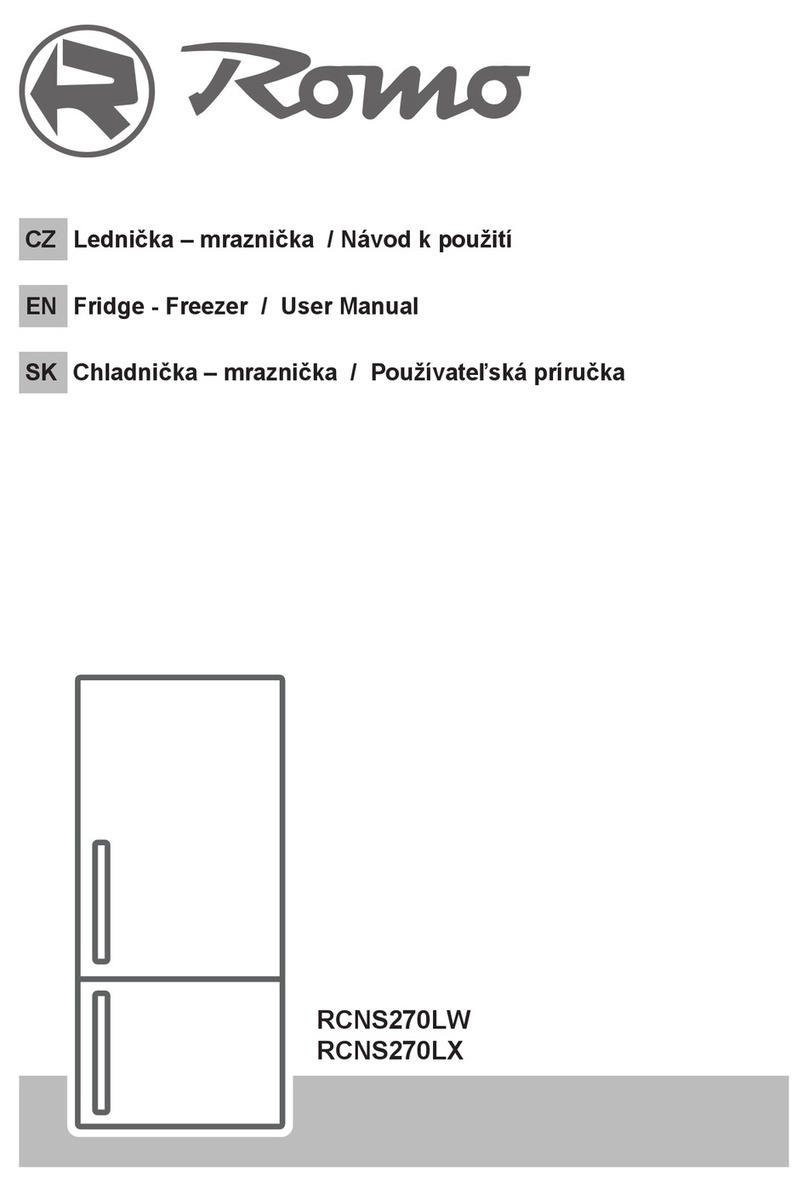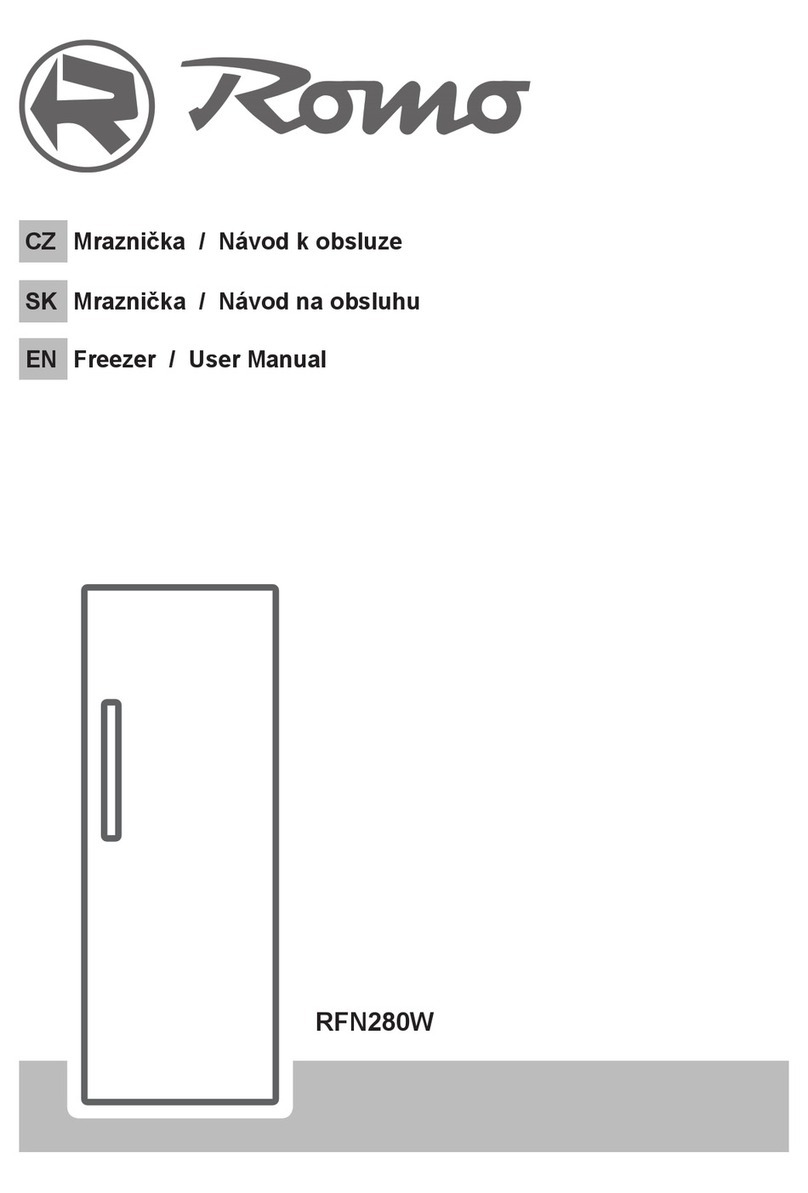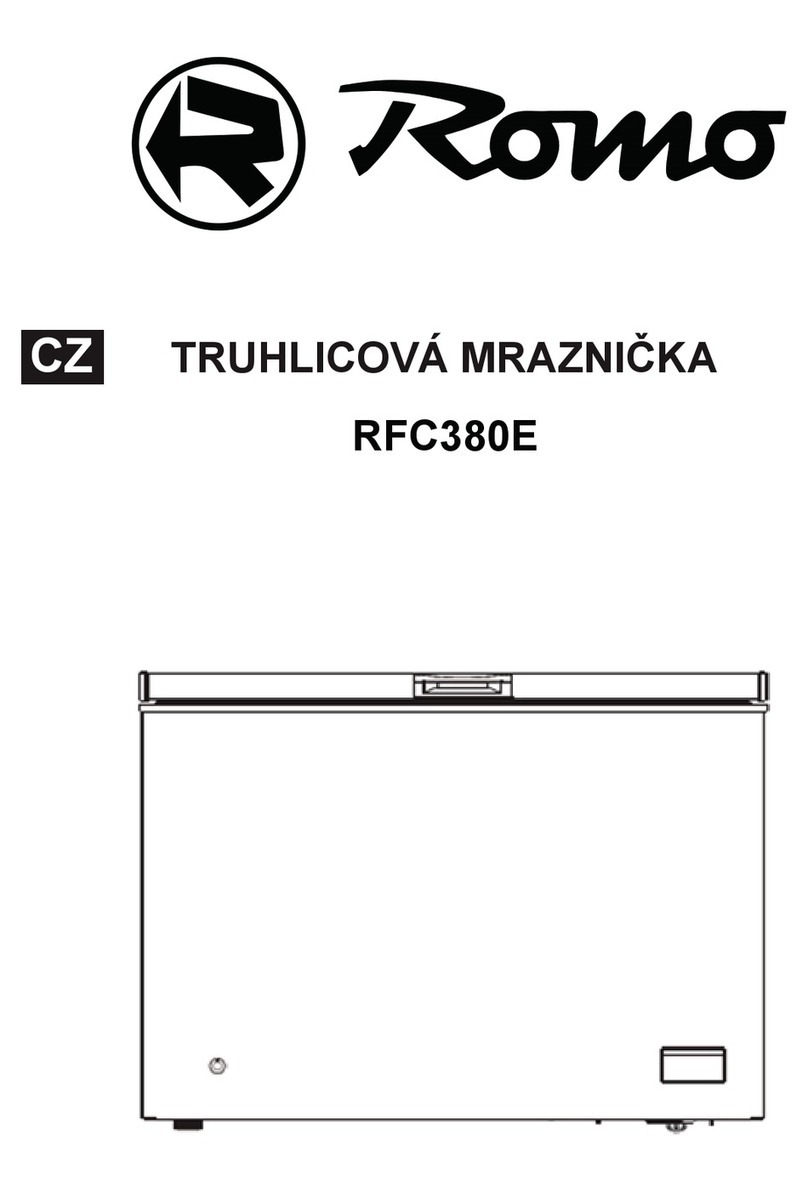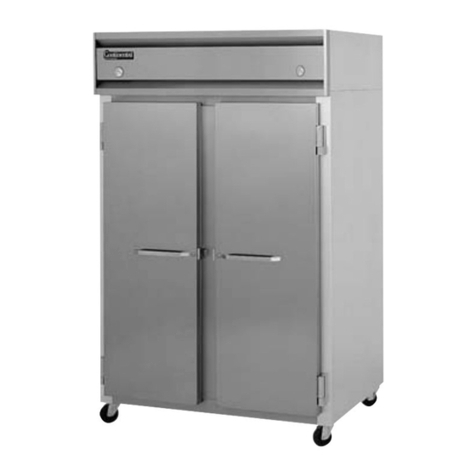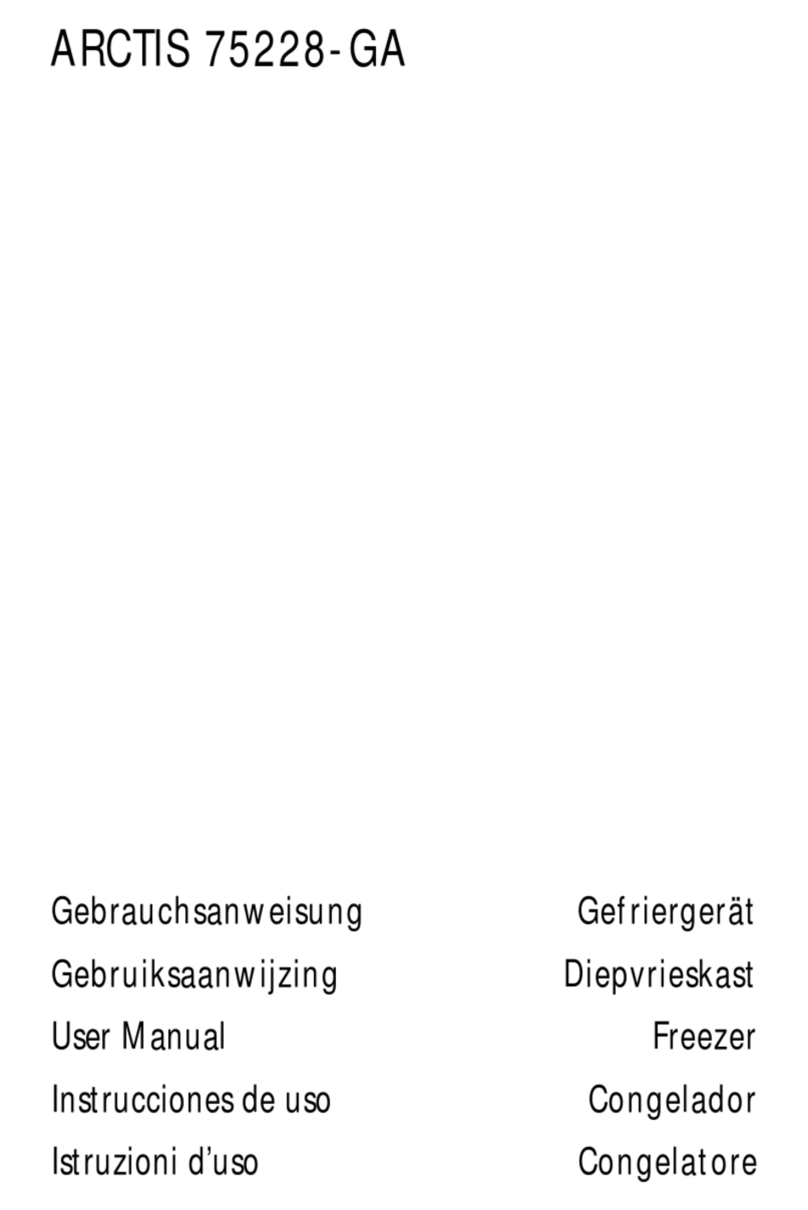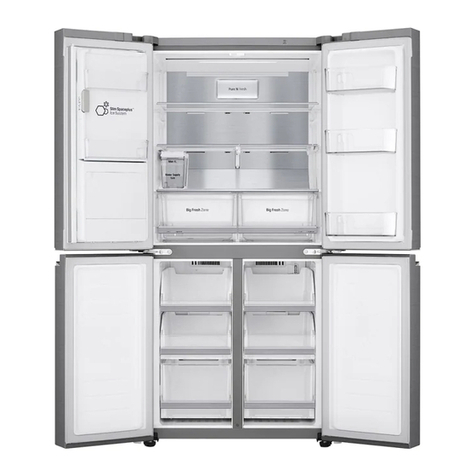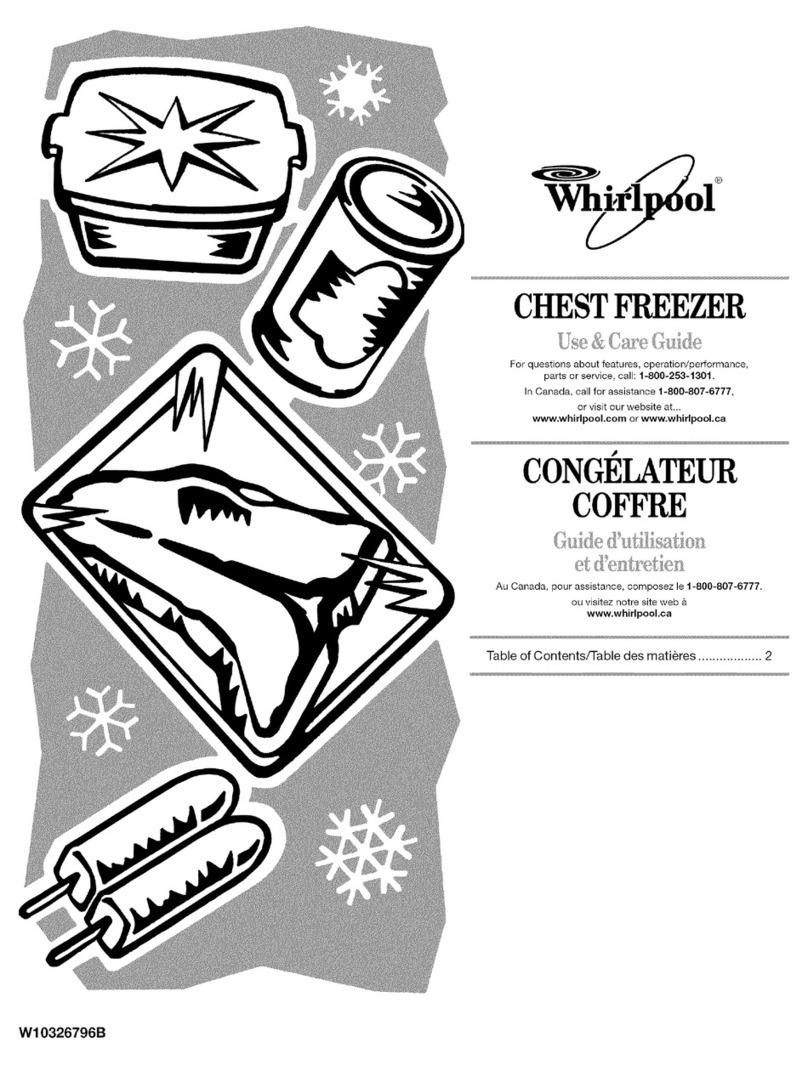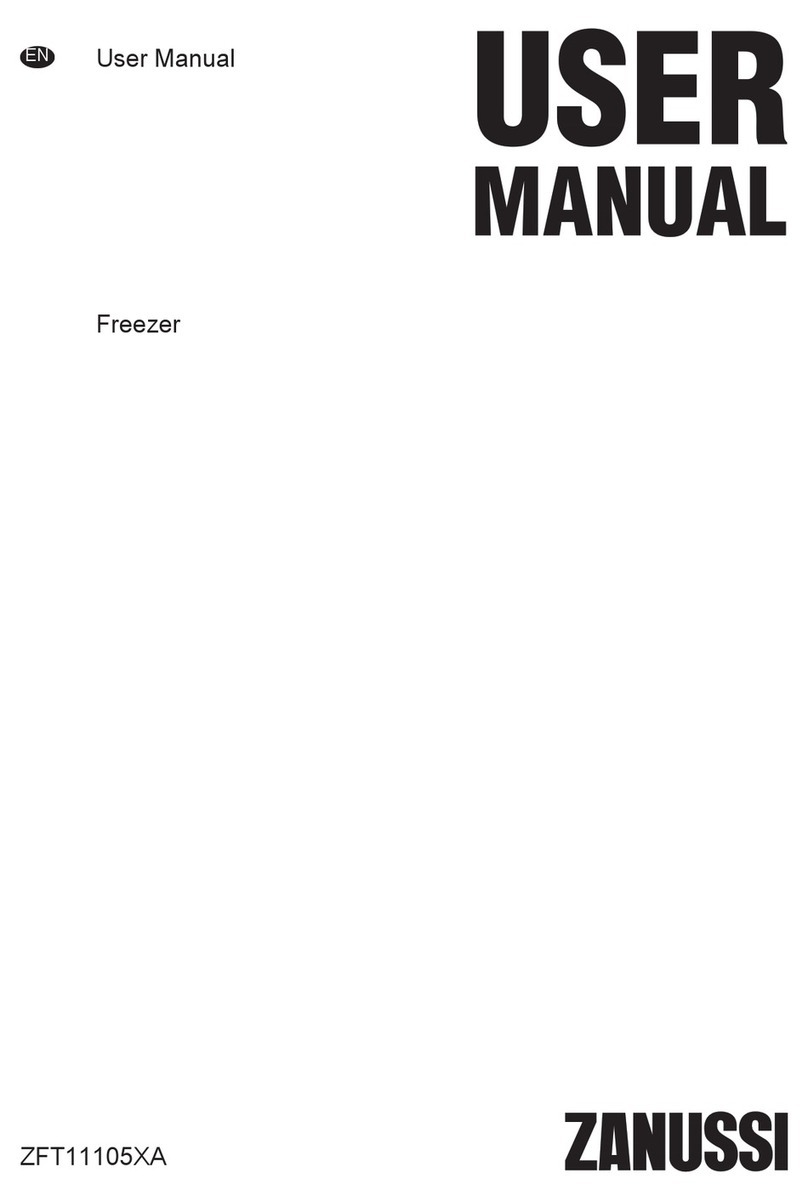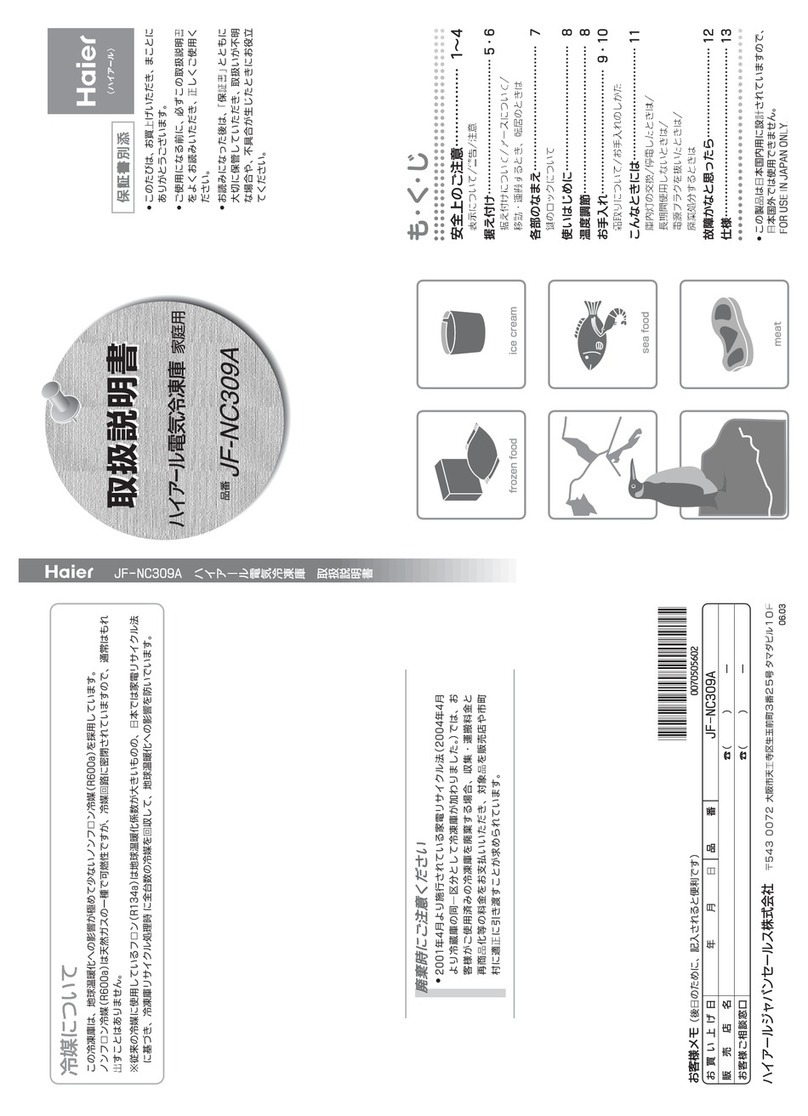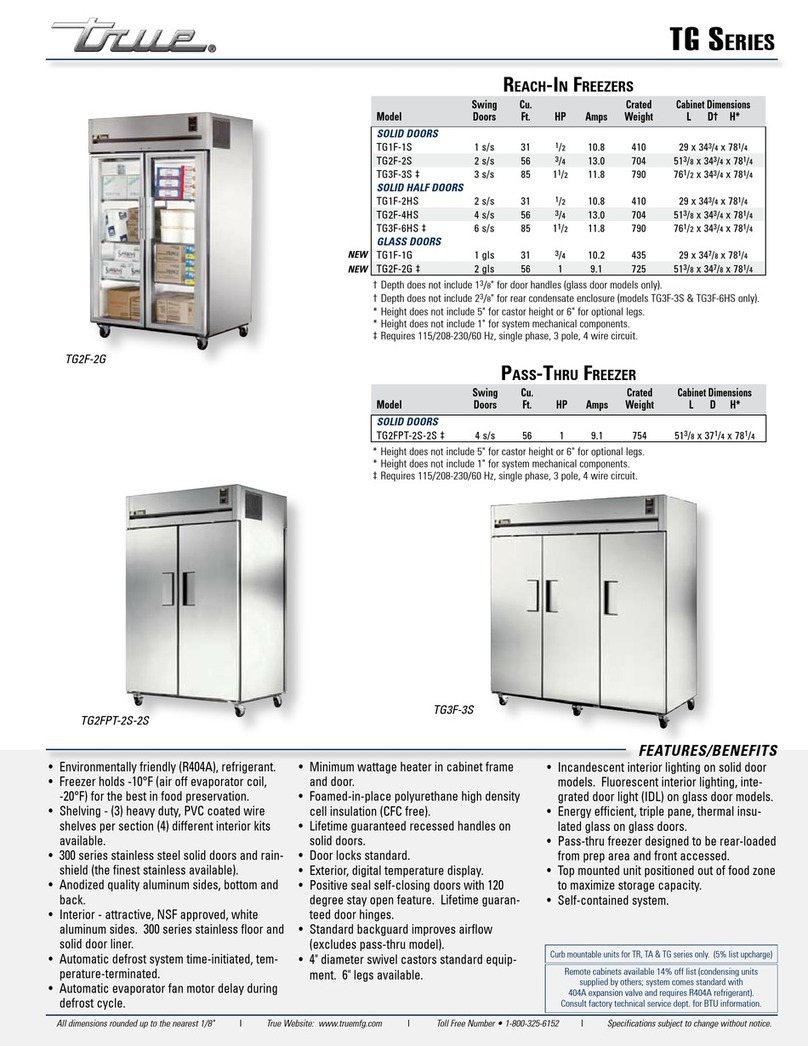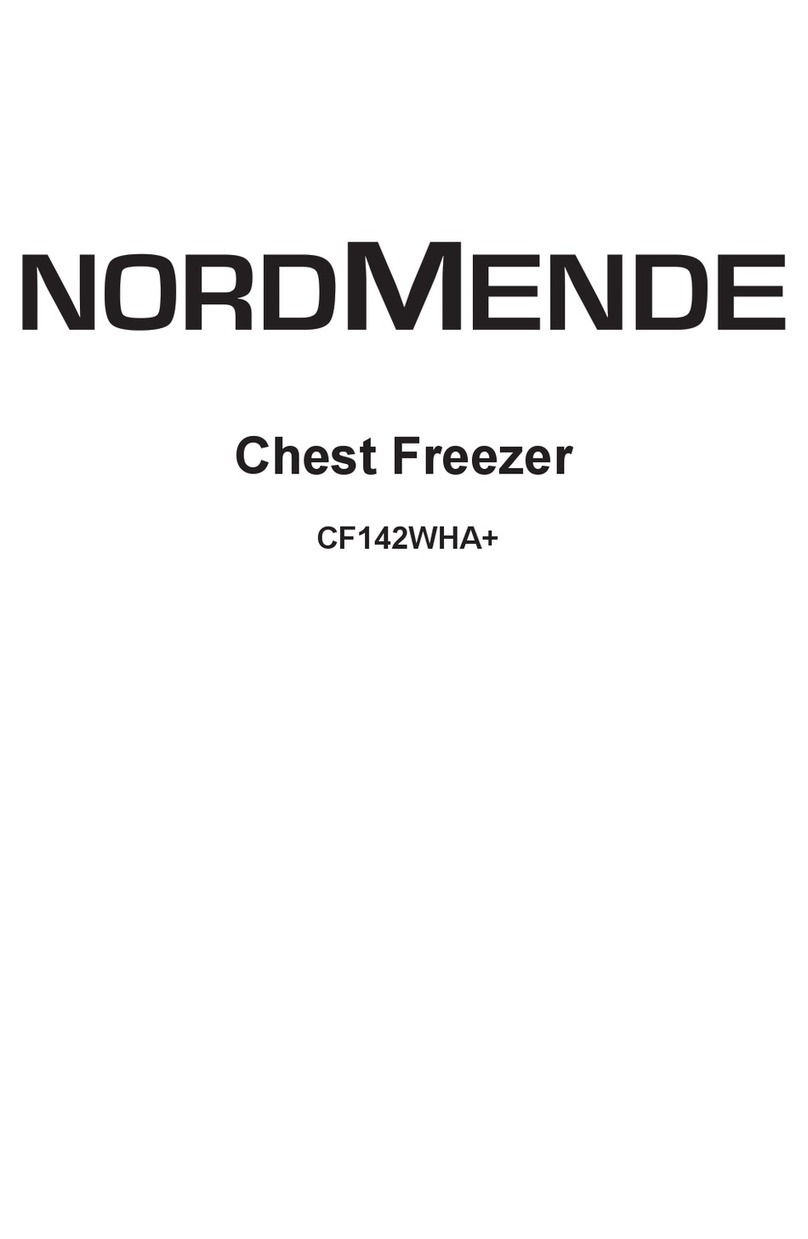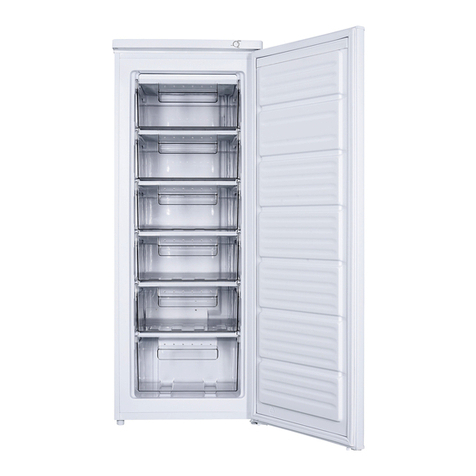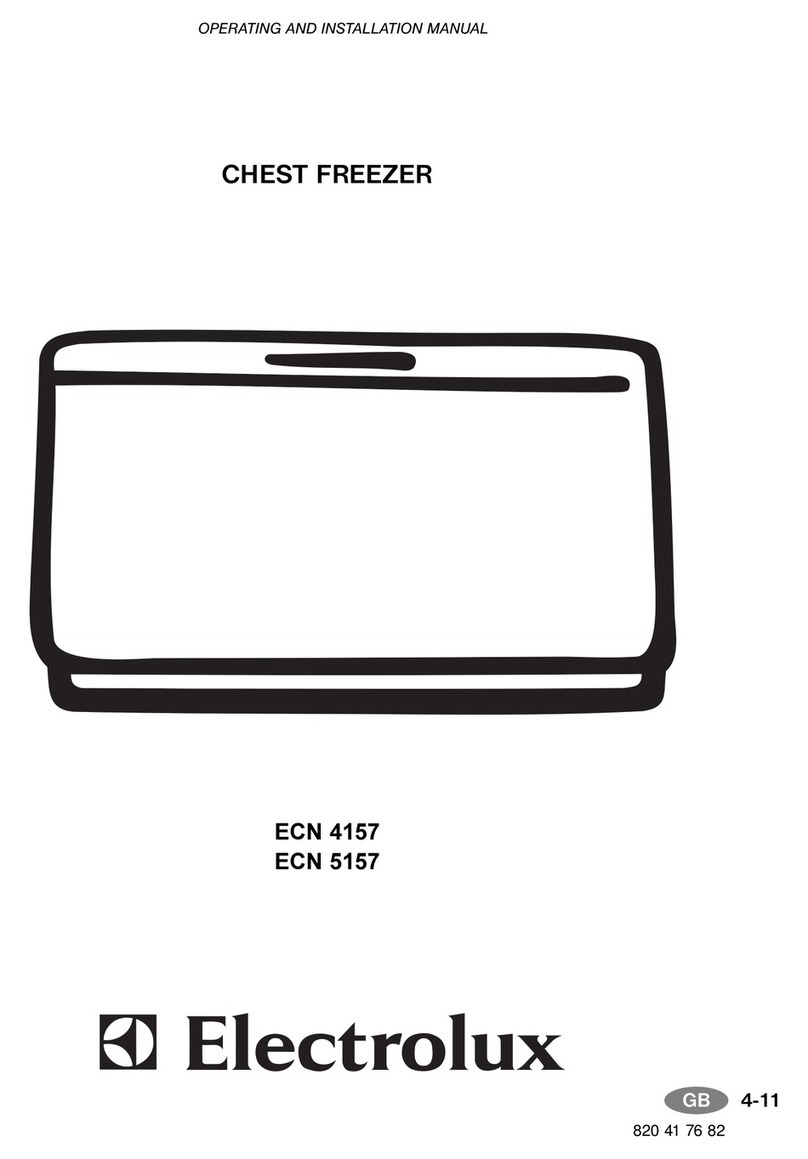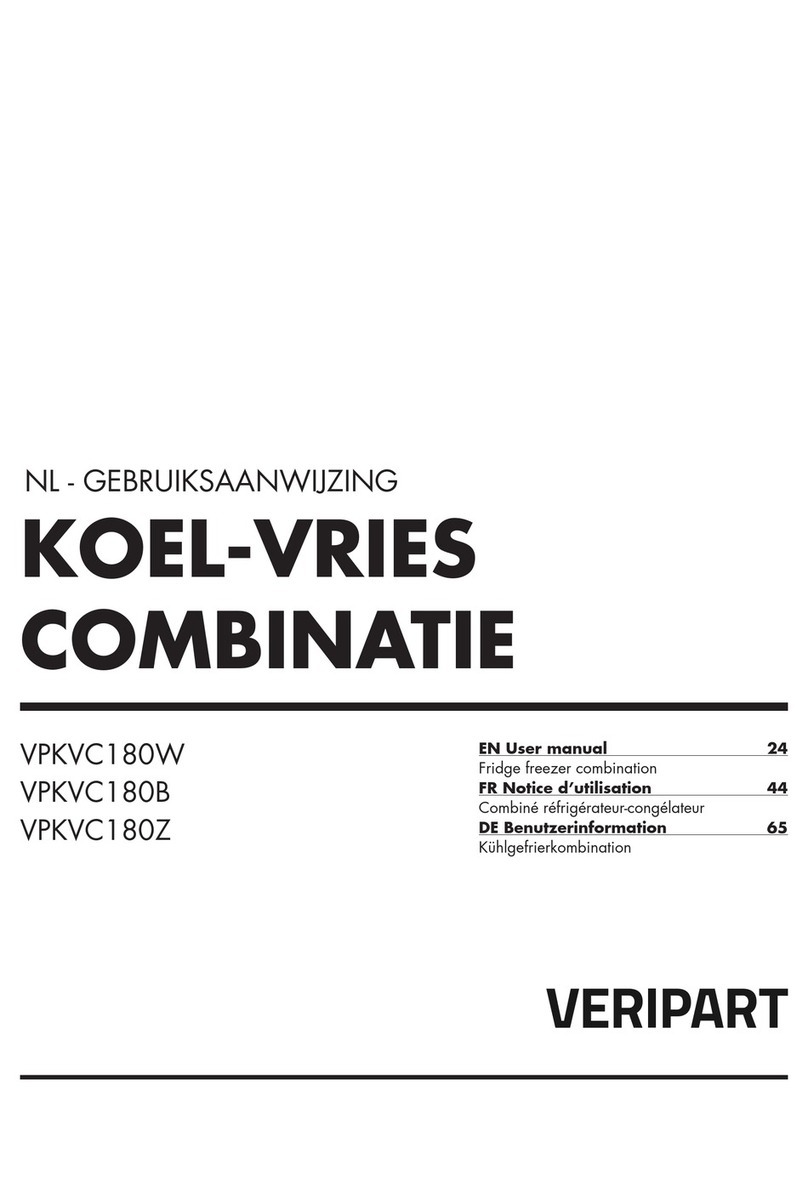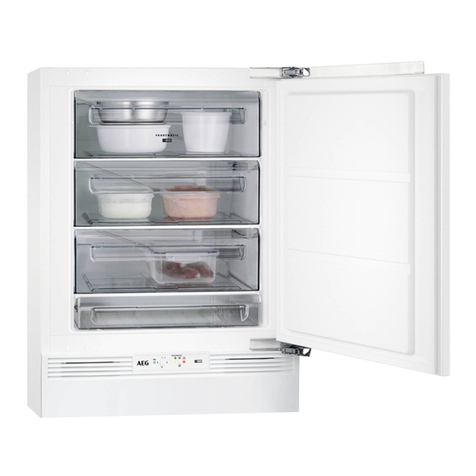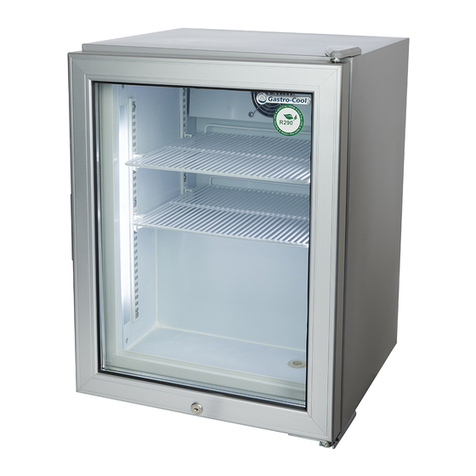Romo RCS2288W User manual

User manual
KOMBINOVANÁ CHLADNIČKA S MRAZNIČKOU
Návod k obsluze
KOMBINOVANÁ CHLADNIČKA S MRAZNIČKOU
Návod na obsluhu
88

EN - 2 -
General warnings ........................................................................................2
Old and out-of-order fridges ........................................................................6
Safety warnings ...........................................................................................6
Installing and operating your fridge .............................................................7
Before using your fridge freezer ..................................................................8
Information on Less Frost Technology.........................................................8
Thermostat setting.......................................................................................8
Warnings about temperature adjustments...................................................9
Accessories ...............................................................................................10
Ice tray .....................................................................................................................10
Plastic scraper..........................................................................................................10
Bottle holder.............................................................................................................10
Humidity Controler ...................................................................................................10
Refrigerator compartment.......................................................................... 11
Freezer compartment ................................................................................12
Defrosting ..................................................................................................16
Replacing the Light bulb ............................................................................17
Repositioning the door...............................................................................17
Tips for saving energy ...............................................................................19
The operating instructions apply to several models. Dierences may therefore occur.

EN - 3 -
This appliance is not intended to be used as a built-in
appliance.
Keep ventilation openings, in the appliance
enclosure or in the built-in structure, clear of obstruction.
Do not use mechanical devices or other
means to accelerate the defrosting process, other than
those recommended by the manufacturer.
Do not use electrical appliances inside the
food storage compartments of the appliance, unless they
are of the type recommended by the manufacturer.
Do not damage the refrigerant circuit.
In order to avoid any hazards resulting
from the instability of the appliance, it must be xed in
accordance with the following instructions:
When positioning the appliance, ensure
the supply cord is not trapped or damaged.
Do not locate multiple portable socket-
outlets or portable power supplies at the rear of the
appliance.
SYMBOL ISO 7010 W021
Risk of re / ammable materials
• If your appliance uses R600a as a refrigerant (this
information will be provided on the label of the cooler) you
should take care during transportation and installation
to prevent the cooler elements from being damaged.
R600a is an environmentally friendly and natural gas,
but it is explosive. In the event of a leak due to damage
of the cooler elements, move your fridge away from

EN - 4 -
open ames or heat sources and ventilate the room
where the appliance is located for a few minutes.
• While carrying and positioning the fridge, do not damage
the cooler gas circuit.
• Do not store explosive substances such as aerosol cans
with a ammable propellant in this appliance.
• This appliance is intended to be used in household and
domestic applications such as:
- sta kitchen areas in shops, oces and other working
environments.
- farm houses and by clients in hotels, motels and other
residential type environments.
- bed and breakfast type environments;
- catering and similar non-retail applications.
• If the socket does not match the refrigerator plug, it
must be replaced by the manufacturer, a service agent
or similarly qualied persons in order to avoid a hazard.
• A specially grounded plug has been connected to the
power cable of your refrigerator. This plug should be
used with a specially grounded socket of 16 amperes. If
there is no such socket in your house, please have one
installed by an authorised electrician.
• Children aged from 3 to 8 years are allowed to load
and unload refrigerating appliances. Children are not
expected to perform cleaning or user maintenance
of the appliance, very young children (0-3 years old)
are not expected to use appliances, young children
(3-8 years old) are not expected to use appliances
safely unless continuous supervision is given, older
children (8-14 years old) and vulnerable people can

EN - 5 -
use appliances safely after they have been given
appropriate supervision or instruction concerning use of
the appliance. Very vulnerable people are not expected
to use appliances safely unless continuous supervision
is given.
• This appliance can be used by children aged from 8
years and above and persons with reduced physical,
sensory or mental capabilities or lack of experience
and knowledge if they have been given supervision or
instruction concerning use of the appliance in a safe way
and understand the hazards involved. Children shall not
play with the appliance. Cleaning and user maintenance
shall not be made by children without supervision.
• If the supply cord is damaged, it must be replaced by
the manufacturer, an authorised service agent or similar
qualied persons, in order to avoid a hazard.
• This appliance is not intended for use at altitudes
exceeding 2000 m.
• Opening the door for long periods can cause a signicant
increase of the temperature in the compartments of the
appliance.
• Clean regularly surfaces that can come in contact with
food and accessible drainage systems.
• Store raw meat and sh in suitable containers in the
refrigerator, so that it is not in contact with or drip onto
other food.
• Two-star frozen-food compartments are suitable for
storing pre-frozen food, storing or making ice cream and

EN - 6 -
making ice cubes.
• One-, two- and three-star compartments are not suitable
for the freezing of fresh food.
• If the refrigerating appliance is left empty for long periods,
switch o, defrost, clean, dry, and leave the door open to
prevent mould developing within the appliance.

EN - 7 -
• If your old fridge has a lock, break or remove the lock before discarding it, because
children may get trapped inside it and may cause an accident.
• Old fridges and freezers may contain isolation material and refrigerant with CFC or HFC.
Therefore, take care not to harm environment when you are discarding your old
fridges.
Please ask your municipal authority about the disposal of the WEEE reuse, recycle
and recovery purposes.
• Please read the instruction manual carefully before installing and using your appliance.
We are not responsible for the damage occurred due to misuse.
• Follow all instructions on your appliance and instruction manual, and keep this manual in
a safe place to resolve the problems that may occur in the future.
• This appliance is produced to be used in homes and it can only be used in domestic
environments and for the specied purposes. It is not suitable for commercial or
common use. Such use will cause the guarantee of the appliance to be cancelled and
our company will not be responsible for losses incurred.
• This appliance is produced to be used in houses and it is only suitable for cooling / storing
food. It is not suitable for commercial or common use and/or for storing substances
except for food. Our company is not responsible for losses to be incurred in the contrary
case.
• Do not connect your fridge freezer to the mains electricity supply using an extension
lead.
• Do not plug in damaged, torn or old plugs.
• Do not pull, bend or damage the cord.
• This appliance is designed for use by adults, do not allow children to play
with the appliance or let them hang o the door.
• Never touch the power cord/plug with wet hands as this could cause a short
circuit or electric shock.
• Do not place glass bottles or beverage cans in the ice-making compartment
as they can burst as the contents freeze.
• Do not place explosive or ammable material in your fridge. Place drinks
with high alcohol content vertically in the fridge compartment and make
sure that their tops are tightly closed.
• When removing ice from the ice-making compartment, do not touch it. Ice may
cause frost burns and/or cuts.
• Do not touch frozen goods with wet hands! Do not eat ice-cream and ice cubes
immediately after you have taken them out of the freezer department!

EN - 8 -
• Do not touch frozen goods with wet hands. Do not eat ice-cream or ice cubes immediately
after you have taken them out of the ice-making compartment.
• Do not cover the body or top of fridge with lace. This aects the performance of your
fridge.
• Secure any accessories in the fridge during transportation to prevent damage to the
accessories.
• Do not use plug adapter.
Before starting to use your fridge freezer, you should pay attention to the following points:
• The operating voltage for your fridge is 220-240 V at 50Hz.
• The plug must be accessible after installation.
• Your fridge freezer may have a smell when it is operated for the rst time. This is normal
and the smell will fade away when your fridge freezer starts to cool.
• Before connecting your fridge freezer, ensure that the information on the data plate
(voltage and connected load) matches that of the mains electricity supply. If in doubt,
consult a qualied electrician.
• Insert the plug into a socket with an ecient ground connection. If the socket has no
ground contact or the plug does not match, we recommend that you consult a qualied
electrician for assistance.
• The appliance must be connected with a properly installed fused socket. Power supply
(AC) and voltage at the operating point must match with the details on the name plate of
the appliance (name plate is located on the inside left of the appliance).
• We do not accept responsibility for any damages that occur due to ungrounded usage.
• Place your fridge where it will not be exposed to direct sunlight.
• Your fridge should never be used outdoors or exposed to rain.
• Your appliance should be at least 50 cm away from stoves, gas ovens and heater cores,
and at least 5 cm away from electrical ovens.
• When your fridge is placed next to a deep freezer, there should be at least 2
cm between them to prevent humidity forming on the outer surface.
• Do not place heavy items on the appliance.
• Clean the appliance thoroughly, especially the interior, before use (see
Cleaning and Maintenance).
• The installation procedure into the kitchen unit is given in the installation
manual. This product is intended to be used in proper kitchen units only.
• Before using your fridge freezer, wipe all parts with a solution of warm water and a
teaspoon of sodium bicarbonate, then rinse with clean water and dry.
Place all parts in the fridge after cleaning.
• Install the plastic distance guide (the part with black vanes at the rear)
by turning it 90° (as shown in the gure) to prevent the condenser from
touching the wall.
• The refrigerator should be placed against a wall with a free space not
exceeding 75 mm.

EN - 9 -
• When using your fridge freezer for the rst time, or after transportation, keep
it in an upright position for at least 3 hours before plugging into the mains.
This allows ecient operation and prevents damage to the compressor.
• Your fridge freezer may have a smell when it is operated for the rst time. This is normal
and the smell will fade away when your fridge starts to cool.
Thanks to the wrap around evaporator, LessFrost technology oers more ecient cooling,
less manual defrost requirement, and more exible storage room.
Thermostat control
The fridge freezer thermostat automatically regulates the inside temperature of the
compartments. By rotating the knob from position 1 to 5, colder temperatures can be
obtained.
Do not try to rotate knob beyond 1 position it will stop your appliance.
For short-term storage of food in the freezer compartment, you can set the knob
between the minimum and medium position.
For long-term storage of food in the freezer compartment, you can set the knob to
the medium position.
For freezing fresh food. The appliance will work for longer. So, after the desired
condition is reached, return the knob to the previous setting.
Most ecient use of energy is ensured in the
conguration with the drawers in the bottom part of the appliance, and shelves evenly
distributed, position of door bins does not aect energy consumption.
Most Ecient use of energy is ensured in the
conguration with the drawers and bins are on stock position.
Super switch
(In some models)Thermostat knob
Lamp cover

EN - 10 -
• It is not recommended that you operate your fridge in environments colder than 10°C in
terms of its eciency.
• Temperature adjustments should be made according to the frequency of door openings
and the quantity of food kept inside the fridge.
• Your fridge should be operated up to 24 hours according to the ambient temperature
without interruption after being plugged in to be completely cooled. Do not open doors
of your fridge frequently and do not place much food inside it in this period.
• A 5 minute delaying function is applied to prevent damage to the compressor of your
fridge, when you take the plug out and then plug it in again to operate it or when an
energy breakdown occurs. Your fridge will start to operate normally after 5 minutes.
• Your fridge is designed to operate in the ambient temperature intervals stated in the
standards, according to the climate class stated in the information label. We do not
recommend operating your fridge out of stated temperatures value limits in terms of
cooling eectiveness.
This refrigerating appliance is intended to be used at ambient temperatures
ranging from 16 °C to 43 °C.
This refrigerating appliance is intended to be used at ambient
temperatures ranging from 16 °C to 38 °C.
This refrigerating appliance is intended to be used at ambient
temperatures ranging from 16 °C to 32 °C.
This refrigerating appliance is intended to be used at ambient
temperatures ranging from 10 °C to 32 °C.
This switch shall be used as superfreeze switch. For maximum freezing
capacity, please turn on this switch before 24 hours placing fresh food. After placing fresh
food in the freezer, 24 hours ON position is generally sucient. In order to save energy,
please turn o this switch after 24 hours from placingfresh food.
If ambiant temperature is below 16 oC, this switch shall be used as winter
switch and it keeps your fridge above 0 oC while freezer is below -18 oC in low ambiants.

EN - 11 -
• Fill the ice tray with water and place in freezer compartment.
• After the water completely turned into ice, you can twist the tray as shown below to get
the ice cube.
After a period of time frost will build up in certain areas in the freezer compartment.
The frost accumulated in the freezer should be removed periodically. Use the
plastic scraper provided if necessary. Do not use sharp metal objects for this
operation. They could puncture the refrigerator circuit and cause irreparable
damage to the unit.
In order to prevent bottles from slipping or falling over, you can use the bottle
holder. This will also help to prevent the noise made by bottles when opening
or closing the door.
(Only some models)
All written and visual descriptions in the accessories may vary according to
the appliance model.
When the humidity controler in the closed position, it allows
fresh fruit and vegetables to be stored longer.
In case of the crisper is totally full, the fresh dial is located in
front of crisper, should be opened. By means of this the air in
the crisper and humidity rate will be controlled and endurance
life will be increased.
If you see any condensation on glass shelf, humidity control
should be taken into the open positions.

EN - 12 -
The refrigerator compartment is used for storing fresh food for a few days.
• Do not place food in direct contact with the rear wall of the refrigerator compartment.
Leave some space around food to allow circulation of air.
• Do not place hot food or evaporating liquid in the refrigerator.
• Always store food in closed containers or wrapped.
• To reduce humidity and avoid formation of frost, never place liquids in unsealed containers
in the refrigerator.
• Meat of all types, wrapped in packages, is recommended to be placed on the glass shelf
just above the vegetable bin, where the air is colder.
• You can put fruit and vegetables into the crisper without packaging.
• To avoid cold air escaping, try not to open the door too often, and not leave the door open
for a long time.
Some recommendations have been specied below for the placement and storage of your
food in the cooling compartment.
1 week Vegetable bin
2 - 3 Days
Wrapped in plastic foil or bags or in
a meat container
(on the glass shelf)
3 - 4 Days In special door shelf
1 week In special door shelf
Until the expiry date
recommended by the
producer
In special door shelf
1 month In the egg shelf
All shelves
Potatoes, onions and garlic should not be stored in the refrigerator.
• For normal working conditions, it will be sucient to adjust the temperature setting of
your refrigerator to +4 °C.
• The temperature of the fridge compartment should be in the range of 0-8 °C, fresh foods
below 0 °C are iced and rotted, bacterial load increases above 8 °C, and spoils.
• Do not put hot food in the refrigerator immediately, wait for the temperature to pass
outside. Hot foods increase the degree of your refrigerator and cause food poisoning
and unnecessary spoiling of the food.
• Meat, sh, etc. should be store in the chiller compartment of the food, and the vegetable
compartment is preferred for vegetables. (if available)
• To prevent cross contamination, meat products and fruit vegetables are not stored
together.

EN - 13 -
• Foods should be placed in the refrigerator in closed containers or covered to prevent
moisture and odors.
The freezer compartment is used for freezing fresh food and for storing frozen food for the
period of time indicated on packaging, and for making ice cubes.
• When freezing fresh food, wrap and seal the food properly; the packaging should be air
tight and shouldn’t leak. Special freezer bags, aluminum foil (heavy grade, if in doubt
double wrap), polythene bags and plastic containers are ideal.
• To get maximum capacity for freezer compartment, please just use glass shelves for
upper and middle section. For bottom section, please use lower basket.
• The maximum amount of fresh foods that can be loaded in the freezer within 24 hours is
indicated on the name plate (see Freezing Capacity).
• Do not allow the fresh food to be frozen to come into contact with the already frozen food.
• Always mark the date and the content on the pack and do not exceed the stated storage
time.
• In case of a power failure or malfunction, the freezer compartment will maintain a
suciently low temperature for food storage. However, avoid opening the freezer door
to slow down the temperature rise within the freezer compartment.
• Never place warm food in the freezer compartment.
• When purchasing and storing frozen food products, ensure that the packaging is not
damaged.
• The storage time and the recommended temperature for storing frozen food is indicated
on the packaging. For storing and using, follow the manufacturer’s instructions. If no
information is provided, food should not be stored for more than 3 months.
• Place frozen food in the freezer compartment as soon as possible after buying it.
• Once the food has thawed, it must not be refrozen; you must cook it as quickly as possible
in order to consume or to freeze once again.
• Not that; if you want to open again immediately after closing the freezer door, it will not
be opened easily. It’s quite normal! After reaching equilibrium condition, the door will be
opened easily.
• Frozen foods, when thawed, should be cooked just like fresh foods. If they are not cooked
after being thawed they must NEVER be re-frozen.
• The taste of some spices found in cooked dishes (anise, basilica, watercress, vinegar,
assorted spices, ginger, garlic, onion, mustard, thyme, marjoram, black pepper, etc.)
changes and they assume a strong taste when they are stored for a long period.
Therefore, the frozen food should be added little amount of spices or the desired spice
should be added after the food has been thawed.
• The storage period of food is dependent on the oil used. The suitable oils are margarine,
calf fat, olive oil and butter and the unsuitable oils are peanut oil and pig fat.
• The food in liquid form should be frozen in plastic cups and the other food should be
frozen in plastic folios or bags.

EN - 14 -
Wrapping in a foil 6 - 8
Wrapping in a foil 6 - 8
Wrapping in a foil 6 - 8
In small pieces 6 - 8
In pieces 4 - 8
In packages without using spices 1 - 3
In pieces 1 - 3
Should be packaged even if it has
membrane
Wrapping in a foil 4 - 6
Wrapping in a foil 4 - 6
In 2.5 kg portions and as llets 6 - 8
After cleaning the bowels and
scales of the sh, wash and dry it;
and if necessary, cut the tail and
head.
2
4
2 - 4
Cleaned and in bags 4 - 6
In its package, aluminium or
plastic container 2 - 3
In salty water, aluminum or plastic
container 3
Frozen meat should be cooked as fresh meat after being thawed. If the meat is not
cooked after being thawed, it should never be frozen again.

EN - 15 -
Wash and cut to small pieces and boil in
water 10 - 13
Hull and wash and boil in water 12
Cleaned and boil in water 6 - 8
Clean and cut to slices and boil in water 12
Cut the stem, cut into two pieces and
remove the core and boil in water 8 - 10
Washed and boil in water 6 - 9
Take the leaves apart, cut the heart into
pieces, and leave it in water with a little
lemon juice for a while
10 - 12
Cut to pieces of 2cm after washing 10 - 12
Clean and pack with its stem or as sweet
corn 12
Peel and slice 8 - 10
Cut into two pieces and remove the stone 4 - 6
Wash and hull 8 - 12
Adding 10 % of sugar in the container 12
Wash and hull the stems 8 - 12

EN - 16 -
Packet
(Homogenize) Milk In its own packet 2 - 3 Pure Milk – In its own
packet
Cheese-excluding
white cheese In slices 6 - 8
Original package may
be used for short storing
period. It should be
wrapped in foil for longer
periods.
Butter, margarine In its package 6
4 - 6 2 - 3 4-5 (220-225 °C)
3 - 6 1 - 1,5 5-8 (190-200 °C)
1 - 3 2 - 3 5-10 (200-225 °C)
1 - 1,5 3 - 4 5-8 (190-200 °C)
2 - 3 1 - 1,5 5-8 (190-200 °C)
2 - 3 2 - 4 15-20 (200 °C)
• Disconnect the unit from the power supply before cleaning.
• Do not clean the appliance by pouring water.
• Make sure that no water enters the lamp housing and other electrical
components.
• The refrigerator should be cleaned periodically using a solution of
bicarbonate of soda and lukewarm water.
• Clean the accessories separately with soap and water Do
not clean them in the dishwasher.
• Do not use abrasive products, detergents or soaps. After washing, rinse
with clean water and dry carefully. When you have nished cleaning,
reconnect the plugto the mains supply with dry hands.

EN - 17 -
• Clean the condenser with a broom at least twice a year. This
will help you to save on energy costs and increase productivity.
• Defrosting occurs automatically in the refrigerator compartment during operation; the
water is collected by the evaporation tray and evaporates automatically.
• The evaporation tray and the water drain hole should be cleaned periodically with the
defrost drain plug to prevent the water from collecting at the bottom of the refrigerator
instead of owing out.
• You can also clean the drain hole by pouring ½ glass of water down it.
• The frost, which covers the shelves of the freezer compartment, should be removed
periodically.
• Do not use sharp metal objects for this operation. They could puncture the refrigerant
circuit and cause irreparable damage to the unit. Use the plastic scraper provided.
• When there is more than 5 mm of frost on the shelves, defrosting must be carried out.
• Before defrosting, place the frozen food in a cool place after wrapping it in sheets of
newspaper (this will help the food to maintain
it’s tempertaure for longer).
• To accelerate the defrosting process, place one
or more bowls of warm water in the freezer
compartment.
• Dry the inside of the compartment with a sponge
or a clean cloth.
• Once the unit has been defrosted, place the
food into freezer and remember to consume it
in a short period of time.

EN - 18 -
• The original packages and foamed polystyrene (PS) can be retained if required.
• During transportation, the appliance should be secured with a wide string or a strong
rope. The instructions written on the corrugated box must be followed while transporting.
• Before transporting or changing the installation position, all
the moving objects (ie,shelves,crisper…) should be taken
out or xed with bands in order to prevent them from getting
damaged.
!Carry your fridge in the upright position.
When replacing the bulb of the refrigerator compartment;
1. Unplug the unit from the power supply,
2. Press the hooks on the sides of the light cover top and remove the light cover
3. Change the present light bulb with a new one of not more than 15 W.
4. Replace the light cover and after waiting 5 minutes plug the unit.
If your refrigerator has LED lighting contact the help desk as this should be changed by
authorized personnel only.
• It is not possible to change the opening direction of your refrigerator door, if the door
handles on your refrigerator are installed from the front surface of the door.
• It is possible to change the opening direction of the door on models without any handles.
• If the door opening direction of your refrigerator may be changed, you should contact the
nearest authorised service agent to have the opening direction changed.

EN - 19 -
If your refrigerator is not working properly, it may be a minor problem, therefore check the
following.
• There is no power,
• The general switch in your home is disconnected,
• The socket is not faulty. To check this, plug the appliance in to another socket which you
know is working.
• You have overloaded the appliance,
• The thermostat setting is on position “1” (if so set the thermostat dial to a suitable value).
• The doors are closed properly,
• There is no dust on the condenser,
• There is enough space at the rear and side walls.
• Normal motor noise: This noise means that the compressor operates normally
• Compressor may cause more noise for a short time when it starts.
• This noise is caused by the ow of the refrigerant in the tubes of the system.
• If you hear any other noises check that:
- The appliance is level
- Nothing is touching the rear of the appliance
- The objects on the appliance are vibrating.
The drain hole for defrost water is not clogged (use defrost drain plug to clean the drain hole).
• In case of a sudden power loss or disconnecting and reconnecting of the plug to the
electrical socket, the compressor protective thermal element will be opened as the
pressure of the gas in the cooling system of your refrigerator has not yet been balanced.
4 or 5 minutes later, your refrigerator will start to operate; this is normal.
• If you won’t be using your refrigerator for a long time (such as on summer holidays),
please disconnect the plug from the socket. Clean your refrigerator as per Part 4 of this
document and leave the door open to prevent any humidication or odor formation.
• If there is still a problem with your refrigerator although you have followed the instructions
in this book, please consult your nearest authorized service center.

EN - 20 -
• The lifetime of your appliance is stated and declared by the Department of Industry. The
length of time for retaining parts required for the proper operation of the appliance is 10
years.
1. Install the appliance in a cool, well ventilated room , but not in direct sunlight and not
near a heat source (radiator, cooker.. etc). Otherwise use an insulating plate.
2. Allow warm food and drinks to cool down outside the appliance.
3. When thawing frozen food, place it in the refrigerator compartment. The low
temperature of the frozen food will help to cool the refrigerator compartment when it is
thawing. This will help to save energy. If the frozen food is put out, it results in a waste
of energy.
4. Cover drinks or other liquids when placing them in the appliance Otherwise humidity
increases in the appliance. Therefore, the working time gets longer. Also covering
drinks and other liquids helps to preserve smell and taste.
5. Try to avoid keeping the doors open for long periods or opening the doors too
frequently as warm air will enter the cabinet and cause the compressor to switch on
unnecessarily often.
6. Keep the covers of the dierent temperature compartments (crisper, chiller ...etc )
closed
7. Door gasket must be clean and pliable. Replace gaskets if worn.
8. Energy consumption of your appliance is
declared without drawers and fully loaded in
freezer compartmant.
9. For saving energy, do not use volume
between the load limit and the door, along the
load limit line. Load limit line is also used in
energy consumption declaration.
Load limit line label
Table of contents
Languages:
Other Romo Freezer manuals
